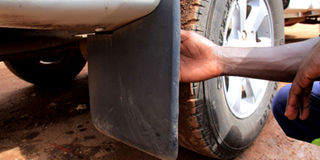Prime
Protect your car, other drivers with mudguards

Mud flaps are also recommended for off-roaders since they usually drive on harsh road conditions and always come in contact with road rocks, mud and other road particles. PHOTO by Rachel Mabala
What you need to know:
On any given day, your car is likely to be covered in mud. While a little mud is inevitable, you can keep splatters from getting out of control with quality mudguards
Ever seen those cars covered in so much dirt, dust and grime that someone scribles, “wash me please” on it using their finger? Well, self-cleaning cars are the stuff of the future, not the present. For most car owners, maintenance is about the engine, brakes, and tyres often for aesthetics. While you may think a little mud staying longer on the car body is not a big deal, hold that thought, because the ally for small problems to worsen with time.
According to Jimmy Kasumba, a mechanical engineer at United Auto Garage in Namuwongo, a car’s metal, exposed to moisture can start to rust. To him, to stop this corrosive process from getting out of hand, getting mud flaps for your vehicle is a must.
Mud flaps, also called mudguards or splash guards help to protect the vehicle from debris and different road conditions you may encounter. Most mechanics around the city call them ‘akalevu’ literally meaning beard.
This is essential, especially because your tyres are constantly coming in contact with mud, dirt, rocks, rock chippings, salt, water and other elements found on the road. Mud flaps prevent dirt from reaching sensitive parts of the vehicle, especially the undercarriage which is prone to rust and corrosion. Most people rarely, if ever, look underneath their vehicle. It is a role they leave to mechanics yet the undercarriage often tells a story about the life the vehicle has lived.
Protect the car
Mud flaps are an inexpensive accessory that saves car owners money and time in the future. It provides a hassle-free maintenance while keeping your ride in good condition because it can withstand different weather conditions. Mud flaps are designed to act as barrier between the tyres and the wheel.
Kasumba reasons that during the rainy season, mud flaps prevent splashing mud and water to cars following from behind yet also preventing the car’s body from appearing dirty during rainy seasons.
Augustine Kaija, the proprietor of Pals restaurant in Kireka, says: I would not have a car without mud flaps both front and rear. I remember that the bodywork behind the rear wheels of my Toyota Nadia quickly rusted by the mud when I removed the old ones and took longer to replace them,” he says, adding that mud flaps also help improve the car’s appearance yet for some creative drivers, they scribble significant messages they communicate to us for insight or laughter.
Cost
Mud flaps are also recommended for off-roaders since they usually drive in harsh road conditions and always come in contact with rock chippings, mud and other nasty particles. Cars, driven especially in arid areas such as Karamoja, have their tyres wear out quickly but that effect can also be extended to areas mud flaps cover. They come in different styles which can be matched to the vehicle. There are different brands on sale in used car parts shops around Kampala, especially Kisekka Market and Ndeeba.
Mud flaps are mainly made from plastic or rubber and some creative craftsmen custom-make guards from used car tyres.
A set of four mud flaps for a saloon car such as a Toyota Premio costs Shs200,000 while the ones made in Uganda, cost Shs80,000. Kasumba prefers the original parts from Japan which he says fit well on cars.
Making a choice
The plastic mud flaps are commonly seen on cars while the rubber flaps are usually found on truck and heavy-duty vehicles. Plastic-made guards are durable enough for lightweight cars. It can withstand harsh weather conditions and prevent stone chippings that may cause dents on some part of the vehicle.
On the other hand, the rubber material, though durable as plastic are more flexible, which makes them ideal for bigger size vehicles. The plastic mud guards can get stuck onto the tyres, especially for bigger size vehicle yet the rubber ones can sail out of the way because of it flexibility.
“I have never bothered placing them on my Volkswagen Golf car but my mechanic once told me that they are very effective in catching some of the mud that would otherwise accumulate on the doors,” says Michael Kalyesubula, a lecturer at Kampala University.
Maintenance
There is no headache when it comes to cleaning mud flaps. Dust can be wiped off easily while tougher grime can be washed off with soap and rinsed with water.
Downside
Kasumba says although mud flaps are a great accessory, they tend to mark paintwork where they are connected to the car. “Mountings tend to cause damage where clamped to the car’s body,” he says. He adds that mountings act as mud trap, causing corrosion to make matters worse. But he notes that proper and regular cleaning can deal with this challenge.
Knowing the options
Decide how heavy-duty you need your mud guards to be. Casual off-roaders may not need the same protection as drivers who frequently off-road. If you plan on driving off-road or in more extreme weather conditions frequently, you may want to invest in heavier-duty mud guards.
Decide whether you want custom guards or universal ones. As you can guess, universal guards are going to be less expensive, but may not fit as nicely as custom guards. Guards that are custom fit for your vehicle are going to be the most effective at stopping potentially harmful debris from kicking up into your wheel well or into other body components.


